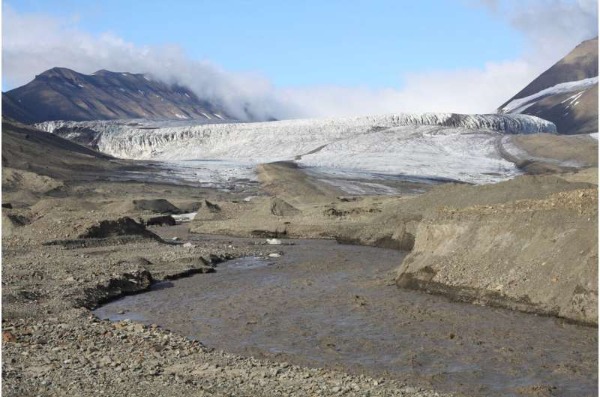As I have reported many times in this space, the rapidly melting ice and snow on the Arctic Ocean is a cause for serious concern.
This is the climate factor over which we have the least control, individually and collectively. Shortly after we experience the first ice-free Arctic Ocean since civilizations have appeared on Earth, we will lose habitat for humans and almost certainly all life on Earth.
An article published at Phys.Org is titled ‘Glacial fracking’: A hidden source of Arctic greenhouse gas emissions. Published on 19 February 2025, the article points to a peer-reviewed, open-access paper in Biogeography. Well into the article at Phys.Org, we learn that “The Arctic is warming at four times the global average, and glaciers across the region are shrinking rapidly. As they melt, more methane could be released, creating a positive feedback loop—where warming melts glaciers, releasing methane, which in turn traps more heat in the atmosphere and accelerates further melting.” In other words, yet another self-reinforcing feedback loop has been identified.
The first two paragraphs of the article at Phys.Org provide a compelling overview of the research and its results: “Gabrielle Kleber and Leonard Magerl, postdoctoral researchers at iC3 [the Centre for ice, Cryosphere, Carbon and Climate], have discovered that Arctic glaciers are leaking significant amounts of methane, a potent greenhouse gas.
They found that glacial melt rivers and groundwater springs are transporting large volumes of methane from beneath the ice to the atmosphere. This previously unrecognized process could contribute to Arctic climate feedbacks, accelerating global warming.”
The third paragraph reveals the importance of this work: “Methane emissions from Arctic wetlands, permafrost, and geological seeps are well known. However, until now, the role of glacial meltwater in mobilizing methane had been largely overlooked.”
The postdoctoral researchers focused on a small valley glacier in central Svalbard, north of Norway. Considerable research has been conducted, and is being conducted, in Svalbard. Svalbard is home to the well-known seed vault that is housing millions of seeds as a response to the ongoing climate crisis.
The article in Phys.Org reports on methane concentrations 800 times higher than the atmospheric equilibrium level. Surprisingly, this methane was not produced by the customary means of microbial activity beneath the ice. Instead, the methane is being released from “methane that has been trapped in the region’s ancient geological formations for millions of years.” This methane is released as the glacier retreats. The retreating glacier allows glacial meltwater to move through fractures in the rocks. This water-borne methane is quickly released into the atmosphere.
One of the postdoctoral researchers, the lead author of the peer-reviewed paper, warns that this self-reinforcing feedback loop could have consequences for the global climate: “Methane is a much more powerful greenhouse gas than carbon dioxide over short timescales. Even though these emissions are seasonal, they could add up as more glaciers retreat.”
I turn now to the peer-reviewed paper, published in Biogeosciences on 6 February 2025. Created by seven scholars, the paper is titled Proglacial methane emissions driven by meltwater and groundwater flushing in a high-Arctic glacial catchment. The Abstract provides a comprehensive overview of the paper: “Glacial groundwater is a conduit for geologic methane release in areas of glacier retreat on Svalbard, representing a large, climate-sensitive source of the greenhouse gas. Methane emissions from glacial melt rivers are known to occur in other regions of the Arctic, but such emissions have not yet been considered on Svalbard. Over the summer of 2021, we monitored methane concentrations in the proglacial groundwater springs and river network of an ∼ 20 km2 valley glacier in central Svalbard to estimate melt season emissions from a single catchment. We measured methane concentrations in the glacial river of up to 3170 nM (nearly 800 times higher than the atmospheric equilibrium concentration) and found the methane to be of thermogenic origin through isotopic analysis. We estimated a total of 1.0 [metric] t[onne] of methane emissions during the 2021 melt season from the catchment, of which nearly two-thirds are being flushed from the glacier bed by the melt river. These findings provide further evidence that terrestrial glacier forefields on Svalbard are hotspots for methane emissions, with a climate feedback loop driven by glacier melt. As the first investigation into methane emissions from glacial melt rivers on Svalbard, our study suggests that summer meltwater flushing of methane from beneath the ∼ 1400 land-terminating glaciers across Svalbard may represent an important seasonal source of emissions. Glacial melt rivers, including those from small valley glaciers, may be a growing emission point for subglacial methane across other rapidly warming regions of the Arctic.”
Whereas the authors conclude that “summer meltwater flushing of methane from beneath the ∼ 1400 land-terminating glaciers across Svalbard may represent an important seasonal source of emissions,” I believe the situation is far more important than this conclusion suggests. As an important “seasonal source of emissions,” this source of methane is an important one that has not previously been reported. As we know, methane is far more powerful than carbon dioxide as a greenhouse gas. Any source of methane, certainly including a source that has not previously been reported, is an important one. Further contributions to an already overheated planet are not welcome. The continued documentation of greenhouse gases is important as an indicator of the surety and rate of our demise.
The bottom line is provided by the final paragraph of the peer-reviewed paper, which cites additional, peer-reviewed literature: “Our study has shown that the meltwater of small valley glaciers like Vallåkrabreen can mobilize a substantial amount of methane, challenging previous theories that subglacial methane is largely produced microbially in the anoxic environment beneath large ice sheets (Wadham et al., 2008). We have demonstrated an alternative methane source in the glacial environment, where ancient thermogenic methane stored in the rocks beneath glaciers is flushed out by meltwater produced by the glacier. This brings thousands of smaller valley glaciers – which lack substantial subglacial environments and previously may have been discounted for their capacity to foster subglacial methane stores – into the spotlight as potential methane emission hotspots. Vallåkrabreen is one of more than 1400 land-terminating glaciers on Svalbard (Nuth et al., 2013), many flowing over geology that is rich in organic carbon, such as shale, coal and sandstone. We suspect that emissions from methane-rich glacial rivers on Svalbard are prevalent across the archipelago and may amount to a large, seasonal source of methane to the region’s atmosphere, which has previously been overlooked. Our findings suggest that methane emissions from glacial rivers is likely more widespread than previously thought, and contributions from valley and mountain glaciers across the Arctic should not be discounted.”
Don’t you hate it when a peer-reviewed paper includes this line: “methane emissions from glacial rivers is likely more widespread than previously thought.”





